MIKROGEN recomBlot CMV IgG [Avidity] recomBlot CMV IgM ...
MIKROGEN recomBlot CMV IgG [Avidity] recomBlot CMV IgM ...
MIKROGEN recomBlot CMV IgG [Avidity] recomBlot CMV IgM ...
- No tags were found...
Create successful ePaper yourself
Turn your PDF publications into a flip-book with our unique Google optimized e-Paper software.
EWestern blotCytomegalovirus (<strong>CMV</strong>)NEWC 0483<strong>recomBlot</strong> <strong>CMV</strong> <strong>IgG</strong> [<strong>Avidity</strong>]<strong>recomBlot</strong> <strong>CMV</strong> <strong>IgM</strong>Immunoblot test with antigens produced by recombinant techniques for the detection of<strong>IgG</strong> or <strong>IgM</strong> antibodies directed against Cytomegalovirus (<strong>CMV</strong>).<strong>MIKROGEN</strong>molekularbiologische Entwicklungs-GmbHHuman Cytomegalovirus (<strong>CMV</strong>) belongs to the family of herpes viruses. Infectionsare common world-wide. The virus persists during the whole life of the infected patientand transmission can result from contact with infected secretions or direct contactwith mucous membranes, through sexual contacts, from mother to the unborn childand through blood transfusions and transplantations.Most acquired <strong>CMV</strong> infections are often asymptomatic. Clinical pictures vary strongand depend on the age and the immune status. <strong>CMV</strong> infections of immune competentpeople occur in most cases asymptomatic or only with minor symptoms.Immuncompromised patients (during transplantations, HIV-infections, chemotherapy)are often (deadly) infected with <strong>CMV</strong>.Primary infections during pregnancy can, in 40% of all cases, lead to prenatal infectionsand infected premature babies who suffer in 10% of all cases under heavy damages. Avirus, acquired during pregnancy, can also be transmitted vertically. The clinicalconsequences on the other hand are more moderate and the prognosis is good.The <strong>recomBlot</strong> <strong>CMV</strong> is a western blot assay for the confirmation of uncertain andpositive screening results. This assay method allows the proof and identification of<strong>IgG</strong> and <strong>IgM</strong> antibodies against different antigen groups. By using recombinant DNAtechnology highly specific and characteristic proteins can be used. The determinationof different antibodies and the possibility of an additional avidity testing is providingadditional information for the differentiation between a primary infection and areactivation.React. controlIE 1p150CM 2p65gB 1gB 2n Product Advantages• Recombinant antigens, therefore➣ High sensitivity and specificity➣ Easy and clear interpretation due to easy to read bands• Easy test procedure; automation possible• Safe evaluation due to contol sera and kit specific control strip• Separate detection of <strong>IgG</strong> and <strong>IgM</strong> antibodies• Easy and reliable determination of avidity possible• CE label: The <strong>recomBlot</strong> <strong>CMV</strong> tests meet the high standard of the EC directive 98/79/EC on in vitro diagnosticmedical devices (approved by notified body no. 0483, EU certificate from November 18 th 2002)• Excellent determination of infection status by the use of different antigen groups (s. Evaluation)n Recombinant <strong>CMV</strong> antigensRecombinantantigenReading frame / proteinIE 1UL123 / IE 1/ 1p150UL32/ pp150C M 2UL44,UL57 / p52 (DBP)p65UL83 / pp65gB 1gB 2UL55 / gBUL55 / gBD escriptionSize [kDa]Non structure protein,"immediate-early"-protein53Tegumentprotein50Nonstructure protein45Tegumentprotein31Membraneglycoprotein gB25Membraneglycoprotein gB18
n Testprinciple and Procedure1 st Incubation: A test strip loaded with <strong>CMV</strong> antigens is incubated with dilutedserum or plasma in a dish for 60 min.wash 3 timesEEE2 nd Incubation: Peroxidase conjugated anti-human antibodies (<strong>IgG</strong> or <strong>IgM</strong>specific) are added. Incubate for 45 min.wash 3 times3 rd Incubation: 5 - 10 minutes after addition of the coloring solution, insolublecolored bands develop at the sites on the test stripsoccupied by antibodies.n EvaluationThree examplary courses of <strong>CMV</strong> infections. The sera were kindly donated by Dr. Benedikt Weissbrich, Institute forVirology and Immunology, University of Würzburg.IIE 1p150CM 2p65gB 1gB 2IE 1p150CM 2p65gB 1gB 2Day ofsampledonationELISA<strong>IgG</strong> <strong>IgM</strong>1 positive positive21 positive positive84 positive positive182 positive positiveClinical dataNone(immune competentperson)II1 negative negativ34 negative equivocal47 positive positive84 positive positive149 positive positive425 positive positiveKidney transplantation,patient was <strong>CMV</strong> negativeprior to transplantationand received positive organIII1 negative negative8 positive positive24 positive positive48 positive positive150 positive negative332 positive negativeNone(immune competentperson)<strong>IgG</strong><strong>IgM</strong>RemarksAntibodies against p150 (pp150/UL32) are induced usually during each <strong>CMV</strong> infection. It was seen in a few cases that no anti-p150 occured in the<strong>IgG</strong> response immediately after a primary infection.Moreover, the following additional antibodies after a primary infection may be detected: anti-IE1, anti-CM2 and anti-p65. If there are no moreantibodies detected but these antibodies and anti-p150 (no antibodies against gB1 and gB2), there is evidence for a primary infection. Dependingon the moment of the infection an <strong>IgM</strong> response may be very weak or negative.A past infection is associated with antibodies against the membrane glycoprotein (gB1, gB2) and the p150 with missing <strong>IgM</strong> response. Antibodiesaganinst the membrane glycoprotein (gB1, gB2) are normally found 6 up to 8 weeks after a primary infection with only very rare exceptions.Reactivations often show <strong>IgG</strong> antibodies against p150, the membrane glykoprotein (gB1, gB2) and against CM2, p65 and/or IE1. Besides this, <strong>IgM</strong>reactivity must be taken into consideration, because in the case of a reactivation, <strong>IgM</strong> test results are often positive.n Storage and Shelf LifeAt 4 °C, 9 months from the time of productionn Commercial Product Article No. 5502 <strong>recomBlot</strong> <strong>CMV</strong> <strong>IgG</strong> [<strong>Avidity</strong>]*Reagents for 20 determinationsArticle No. 5503 <strong>recomBlot</strong> <strong>CMV</strong> <strong>IgM</strong>Reagents for 20 determinations* [ ] optional availableas additional reagentArticle No. 11010Blot, Line - avidity reagentReagent for 25 avidity determinations<strong>MIKROGEN</strong> GmbHFloriansbogen 2-4 · D-82061 Neuried · Germany · Tel.: +49 (0)89 54801-0 · Fax: +49 (0)89 54801-100Internet: www.mikrogen.de · eMail: mikrogen@mikrogen.depirbcme007a


![MIKROGEN recomBlot CMV IgG [Avidity] recomBlot CMV IgM ...](https://img.yumpu.com/47840028/1/500x640/mikrogen-recomblot-cmv-igg-avidity-recomblot-cmv-igm-.jpg)

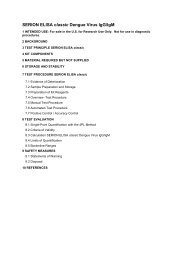
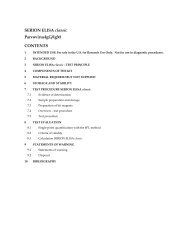
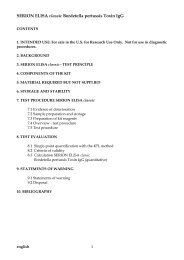
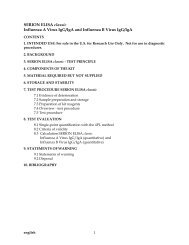

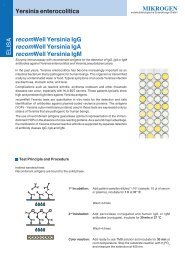
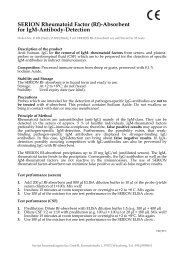

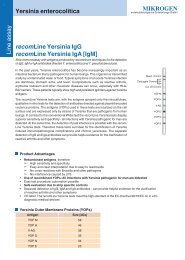
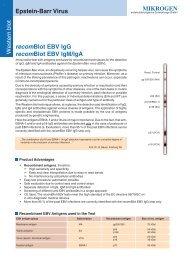
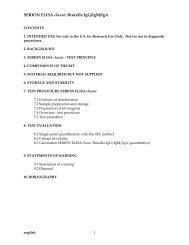

![MIKROGEN recomLine Parvovirus B19 IgG [Avidity] recomLine ...](https://img.yumpu.com/31102785/1/185x260/mikrogen-recomline-parvovirus-b19-igg-avidity-recomline-.jpg?quality=85)